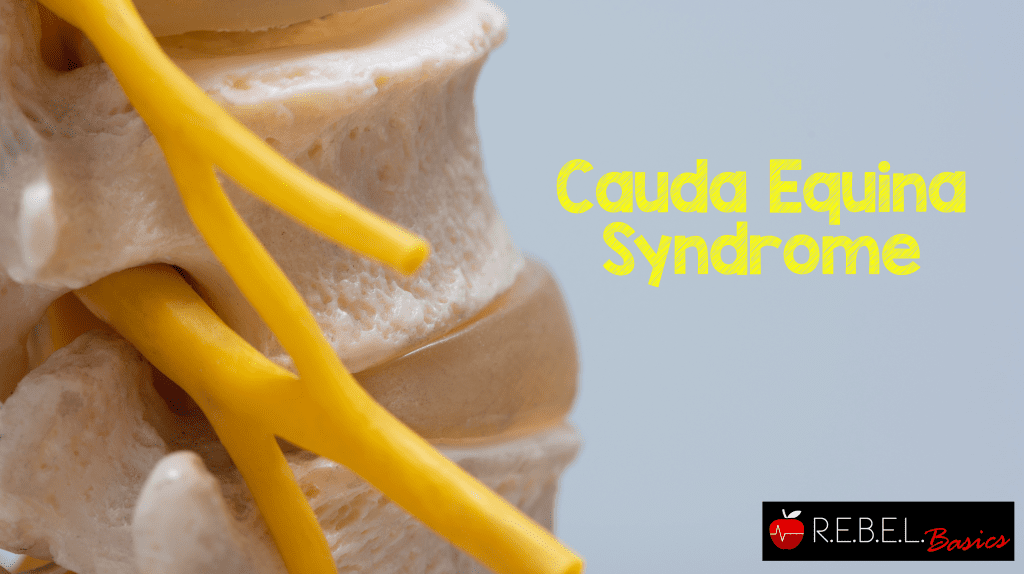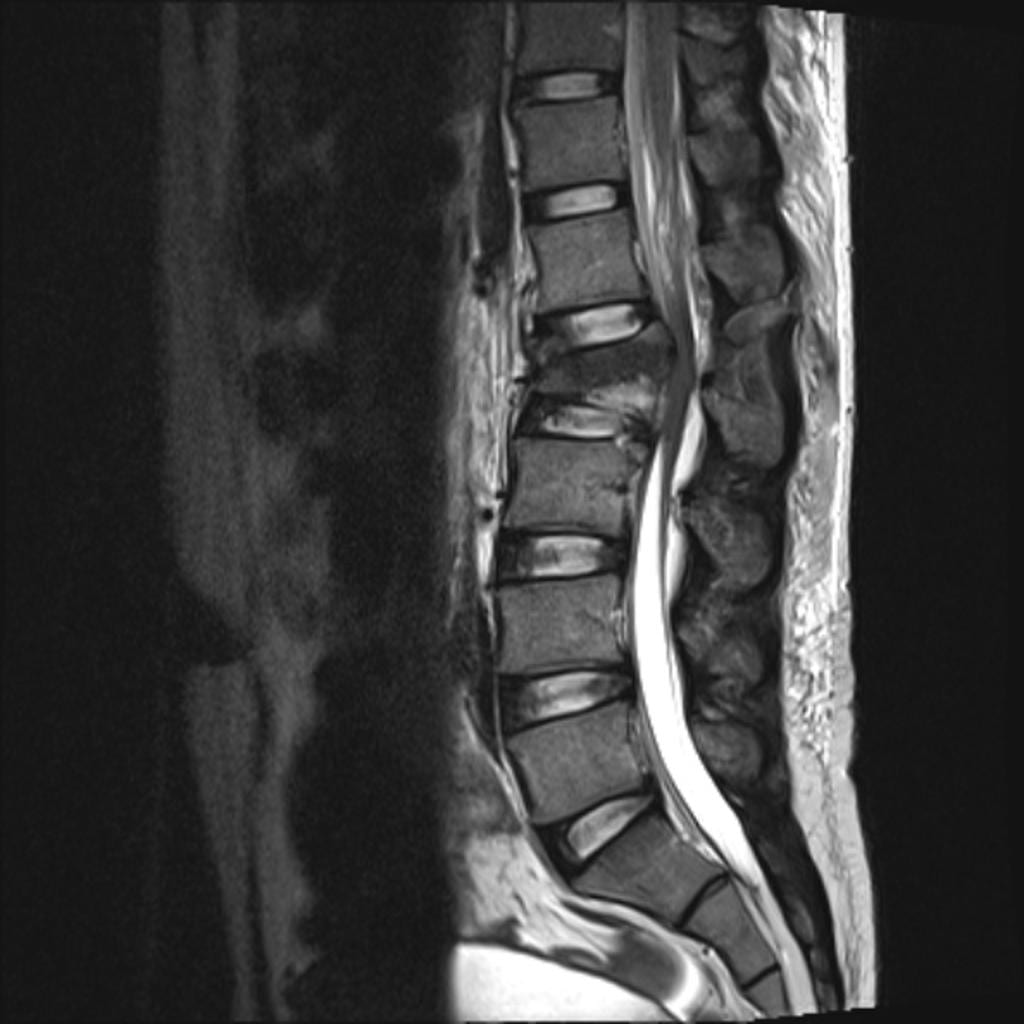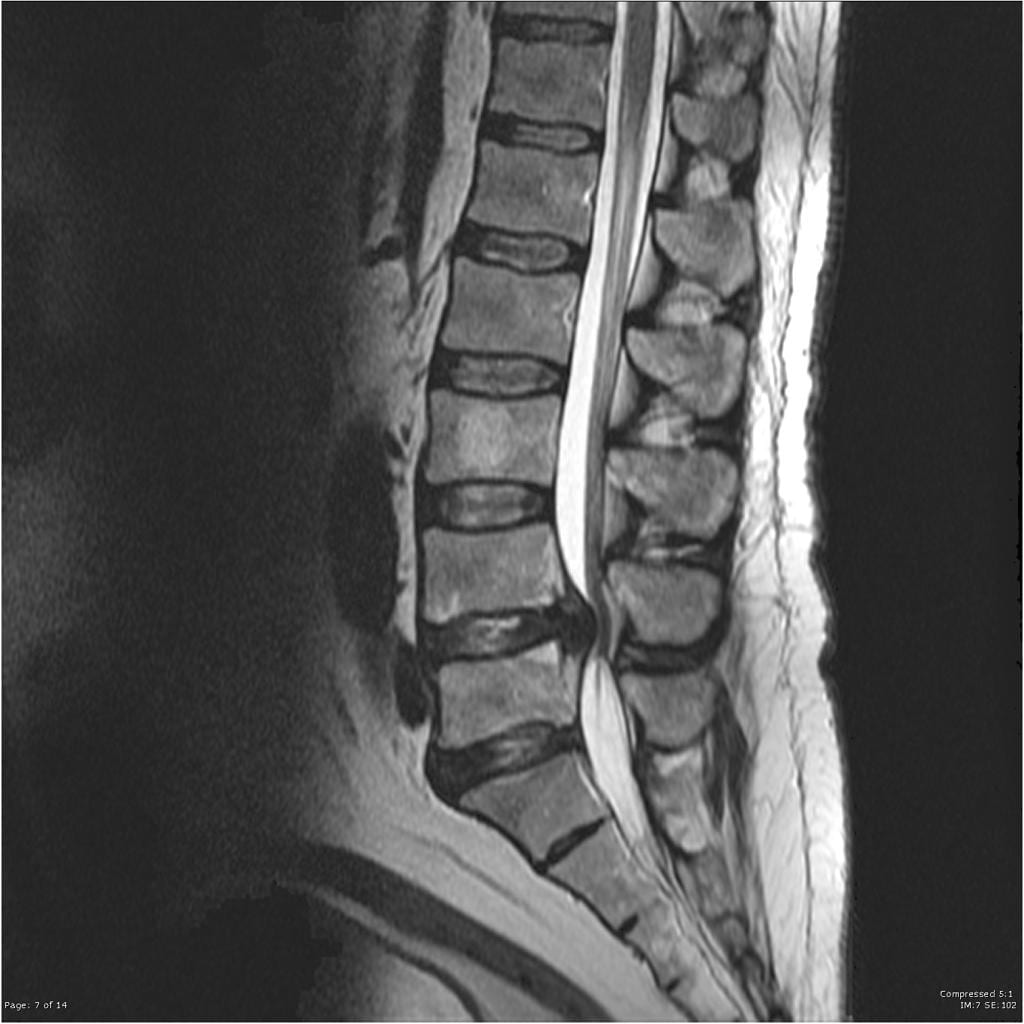
 Definition: Syndrome characterized by dysfunction of multiple lumbar and sacral nerve roots in the lumbar vertebral canal due to compression
Definition: Syndrome characterized by dysfunction of multiple lumbar and sacral nerve roots in the lumbar vertebral canal due to compression
Anatomy
- The spinal cord terminates in the conus medullaris at the T12/L1 vertebral body in adults
-
Cauda equina
- Collection of nerve roots from L1-S5
- Compression from various causes results in lower motor neuron pathology

Compressive Causes:
-

Traumatic Burst Fracture 
Lumbar Disc Herniation Disc herniation (most common cause)
- Epidural abscess
- Spinal epidural hematoma
- Diskitis
- Tumor (metastatic or primary CNS)
- Trauma (retropulsion of fracture fragment)
- Spinal stenosis
Presentation (Lavy 2009):
- Symptoms may develop acutely or progressively over time
-
Symptoms
- Back pain
-
Sciatica
- Seen in up to 97% of patients (Korse 2017)
- Bilateral leg pain and/or weakness common
- Change in sensation in the lower extremities
-
Bladder dysfunction (retention and/or incontinence) – up to 92% (Korse 2017)
- Disruption of autonomic innervation leads to retention and overflow incontinence
- Bowel dysfunction (constipation and/or incontinence) – up to 74% (Korse 2017)
- Decreased sensation in the perianal area – up to 93% (Korse 2017)
- Sexual dysfunction (i.e. impotence)
-
Physical Exam
-

Saddle Paresthesia Lower extremity weakness, numbness or paresthesias (usually bilateral)
- Decreased or absent lower extremity reflexes
- Hypotonia/atrophy of the lower extremities (in chronic presentations)
- Urinary retention (increased post void residual)
- Saddle anesthesia: Reduced or absent sensation in the perineal area (S2-S4 innervation)
- Decreased or absent rectal tone
-
Differential Diagnosis (non-compressive causes of spinal cord dysfunction)
- Multiple Sclerosis
- Transverse Myelitis
- Myelopathies (e.g. HIV related)
- Spinal cord infarction
- Spinal AVM
- Syringomyelia
ED Evaluation and Management:
-
Imaging
-
Bladder US
- Normal post-void residual (PVR) < 50 ml (may be up to 100 ml in patients > 65 years)
- PVR = 0.5 X AP diameter X lateral diameter X sagittal diameter of the bladder
- Plain X-rays and CT scans can show bone and soft tissue abnormalities but not spinal cord abnormalities
-
CT Myelogram
- Allows for visualization of the spinal cord and associated abnormalities
- Requires spinal tap followed by injection of contrast. This limits it’s utility
- Can be used for patients who have contraindications for MRI or when MRI unavailable
-
MRI
- Imaging modality of choice for cauda equine syndrome
- Image types: Obtain sagittal and axial T1 and T2 sequences
-
Bladder US
-
Neurosurgical or orthopedic consultation for emergency surgery
- Surgery should be performed within 24 hours to increase the chance of better outcomes (Todd 2005)
- The presence of urinary retention/incontinence at presentation is a predictor of poor outcomes
Take Home Points
- Cauda equina syndrome is a rare emergency with devastating consequences
- Early recognition is paramount as the presence of bladder dysfunction portends bad functional outcomes
- The presence of bilateral lower extremity weakness or sensory changes should alert clinicians to the diagnosis. Saddle anesthesia (or change in sensation) and any bladder/bowel changes in function should also raise suspicion for the disorder
- MRI is the diagnostic modality of choice though CT myelogram can be performed if necessary
- Prompt surgical consultation is mandatory for all patients with cauda equina syndrome regardless of symptoms at presentation
For More on This Topic Checkout:
- EM Cases: Best Case Ever 11: Cauda Equina Syndrome
- OrthoBullets: Cauda Equina Syndrome
- Radiopaedia: Cauda Equina Syndrome
References:
- Lavy C et al. Cauda Equina Syndrome. BMJ 2009; 338: PMID: 19336488
- Todd NV. Cauda equina syndrome: the timing of surgery probably does influence outcome. Br J Neurosurg 2005;19:301-6 PMID: 16455534
- Korse NS et al. Cauda Equina Syndrome: presentation, outcome and predictors with focus on micturition, defecation and sexual dysfunction. Eur Spine J 2017; 26(3): 894-904. PMID: 28102451
- Perron AD, Huff JS: Spinal Cord Disorders, in Marx JA, Hockberger RS, Walls RM, et al (eds): Rosen’s Emergency Medicine: Concepts and Clinical Practice, ed 8. St. Louis, Mosby, Inc., 2010, (Ch) 106: p 1419-30.
Post Peer Reviewed By: Salim R. Rezaie, MD (Twitter: @srrezaie)
The post Cauda Equina Syndrome appeared first on REBEL EM - Emergency Medicine Blog.

